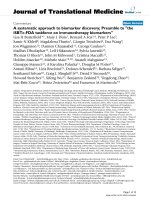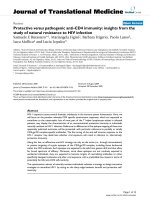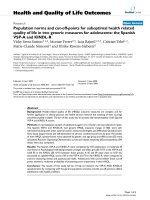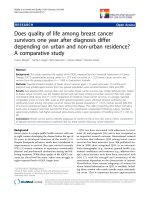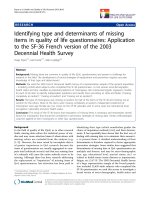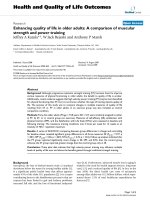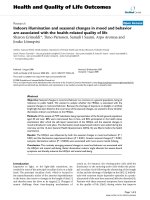báo cáo hóa học:" New quality and quantity indices in science (NewQIS): the study protocol of an international project" docx
Bạn đang xem bản rút gọn của tài liệu. Xem và tải ngay bản đầy đủ của tài liệu tại đây (1.49 MB, 4 trang )
BioMed Central
Page 1 of 4
(page number not for citation purposes)
Journal of Occupational Medicine
and Toxicology
Open Access
Study protocol
New quality and quantity indices in science (NewQIS): the study
protocol of an international project
Beatrix Groneberg-Kloft*
1
, Tanja C Fischer
2
, David Quarcoo
3
and
Cristian Scutaru
3
Address:
1
Otto-Heubner. Centre, Charité-Universitätsmedizin Berlin, Free University Berlin and Humboldt-University Berlin, Germany,
2
Department of Dermatology and Allergy, Charité-Universitätsmedizin Berlin, Free University Berlin and Humboldt-University Berlin, Germany
and
3
Institute of Occupational Medicine, Charité-Universitätsmedizin Berlin, Free University Berlin and Humboldt-University Berlin, Germany
Email: Beatrix Groneberg-Kloft* - ; Tanja C Fischer - ;
David Quarcoo - ; Cristian Scutaru -
* Corresponding author
Abstract
Benchmarking systems are important features for the implementation of efficacy in basic and
applied sciences. These systems are urgently needed for many fields of science since there is an
imbalance present between funding policies and research evaluation. Here, a new approach is
presented with an international study project that uses visualisation techniques for benchmarking
processes. The project is entitled New Quality and Quantity Indices in Science (NewQIS). The
juxtaposition of classical scientometric tools and novel visualisation techniques can be used to
assess quality and quantity in science. In specific, the tools can be used to assess quality and quantity
of research activity for distinct areas of science, for single institutions, for countries, for single time
periods, or for single scientists. Also, NewQIS may be used to compare different fields, institutions,
countries, or scientists for their scientific output. Thus, decision making for funding allocation can
be made more transparent. Since governmental bodies that supervise funding policies and
allocation processes are often not equipped with an in depth expertise in this area, special attention
is given to data visualisation techniques that allow to visualize mapping of research activity and
quality.
Introduction
Progress in science is crucial for the economic develop-
ment of most countries. This advance is commonly
directly related to a country's intramural and extramural
governmental and non-governmental funding policy.
Funding sources are limited. Currently, the economic cri-
sis leads to a further reduction of the sources and both
health care systems and research funding are endangered
[1,2]. Therefore, numerous research projects and grant
proposals may not be financed [3]. This leads to an enor-
mous potential of arising conflicts. The scientific commu-
nity discusses these issues in great detail and there is an
increasing interest in the underlying processes that lead to
the allocation of funding budgets at the international,
national and subnational levels [4-6].
Hypothesis and objectives
We hypothesize that without the use of scientometric
techniques, there will be a growing discontent among sci-
entists for funding allocation policies. In this respect, the
Published: 26 June 2009
Journal of Occupational Medicine and Toxicology 2009, 4:16 doi:10.1186/1745-6673-4-16
Received: 22 May 2009
Accepted: 26 June 2009
This article is available from: />© 2009 Groneberg-Kloft et al; licensee BioMed Central Ltd.
This is an Open Access article distributed under the terms of the Creative Commons Attribution License ( />),
which permits unrestricted use, distribution, and reproduction in any medium, provided the original work is properly cited.
Journal of Occupational Medicine and Toxicology 2009, 4:16 />Page 2 of 4
(page number not for citation purposes)
use of specific benchmarking systems could be of help to
implement transparency within funding allocation proc-
esses.
While single scientometric and bibliometric methods are
known for many areas to dissect research activities of fac-
ulties or single scientists, the use of these techniques is
often hampered. Reviewing the existing policies in Europe
[7] or other general statements [8-11], it becomes clear
that we need an improvement in this area. Therefore, the
present work describes aims to establish an approach to
visualize research quantity and quality indices.
This approach should be usable to assess quality and
quantity of research activity i.e. for 1) distinct areas of sci-
ence, for 2) single institutions, for 3) single countries, for
4) single time periods, or for 5) single scientists (Fig. 1).
In addition to this evaluation, NewQIS studies may also
be used for comparative issues: In this respect, different
fields of science, different institutions, different countries,
or different scientists or different time periods can be
compared in terms of scientific output. Thus, decision
making for funding allocation can also be made more
transparent. Our hypothesis is that this approach is a use-
ful tool for all kind of decision making concerning the
allocation of funding. The approach can be termed "New
Quality and Quantity Indices in Science (NewQQIS)".
Arising from this approach, future NewQIS – studies may
be conducted to provide a sound basis for the analysis and
evaluation of research activity in distinct field of biomed-
icine.
Methods
The methods used for the international NewQIS studies
are based on classic data bases such as the PubMed, Sco-
pus or the Web of Science. Within these data bases, bio-
medical research output can be categorized with the
numbers of published entries as an index marker for
quantity of output. Quantities can be analysed with regard
to different main characteristics: 1) specific fields of sci-
International differences in focus of researchFigure 2
International differences in focus of research. Ranking of organs in each country. Scopus data base search. Data from
[12] Health Res Policy Syst. 2008; 6: 6. Published online 2008 June 13. doi: 10.1186/1478-4505-6-6. Copyright
©
2008
Groneberg-Kloft et al; licensee BioMed Central Ltd.
The NewQIS study protocol can be used to assess research output for 1) distinct areas of science, for 2) institutions, for 3) countries, or for 5) scientistsFigure 1
The NewQIS study protocol can be used to assess
research output for 1) distinct areas of science, for 2)
institutions, for 3) countries, or for 5) scientists.
Journal of Occupational Medicine and Toxicology 2009, 4:16 />Page 3 of 4
(page number not for citation purposes)
ence, specific organs, diseases or other phenomena 2)
countries 3) publication dates 4) authors 5) affiliations
depending on the focus of the study. The data can then be
transferred to visualisation techniques such as density
equalizing calculations.
Study example
Three recently published studies may serve as prototype
examples for the NewQIS approach and were used to
establish the study protocols: Using the two large data-
bases Scopus and Web of Science biomedical research out-
put was categorized with the numbers of published
entries as an index marker for quantity of output [12]. The
quantities were analyzed with regard to three main char-
acteristics: 1) organs 2) countries 3) publication dates.
Density-equalizing mapping was used in this study for the
visualization of data. In this respect, the territories were re-
sized according to a particular variable, i.e. the number of
published items. For the re-sizing procedure the area of
each country was scaled in proportion to its total number
of published items regarding the organs heart, brain, liver,
lung and skin. The specific calculations were based on
Gastner and Newman's algorithm [13]. In total,
5,527,558 published items were analysed in this study
[12]. Using this approach a dichotomy was shown to be
present between Western countries such as the US, UK or
Germany and Asian countries such as Japan, China or
South Korea concerning research focuses (Fig. 2). This was
the first large scale analysis of global research activity and
output over the last 50 years and the approach was used
to establish the NewQIS protocol.
As a second example, the recently published data by
Borger et al can be used [14]. Here, different animal mod-
els of asthma were analysed using in part the presently
proposed NewQIS techniques. Density-equalizing algo-
rithms were used and data was retrieved from the Thom-
son Institute for Scientific Information database Web of
Science. During the period from 1900 to 2006 a number
of 3489 filed items were found to be connected to animal
models of asthma, the first being published in the year
1968 [14]. These studies were published by 52 countries.
The US, Japan and the UK were the most productive coun-
tries, participating in 55.8% of all published items (Fig.
3). When analyzing the average citation per item as an
indicator for research quality Switzerland ranked first
(30.54/item) and New Zealand ranked second for coun-
tries with more than 10 published studies [14]. The 10
most productive journals included 4 journals with a main
focus allergy and immunology and 4 journals with a main
focus on the respiratory system. Two journals had a focus
on pharmacology or pharmacy. In all assigned subject cat-
egories examined for a relation to animal models of
asthma, the field of immunology ranked first. As a last
step the numbers of published items were categorized
with regard to specific animal species. Here it was found
that mice were the preferred species followed by guinea
pigs [14]. In summary it was concluded that the use of ani-
mal models of asthma is restricted to a relatively small
number of countries with major differences in subsets of
the analysis. The differences can be attributed to varia-
tions in the research focus as assessed by subject category
analysis.
In a third example the visualisation procedures were
extended to video analysis in order to be able to assess the
evolution over the time [15]. In this study, the neighbour-
ing fields of cardiovascular and respiratory medicine
served as models for diverging patterns of health research.
Density equalizing mapping procedures were used in
A. Density-equalizing map illustrating the number of publica-tions in each particular countryFigure 3
A. Density-equalizing map illustrating the number of
publications in each particular country. The area of
each country was scaled in proportion to its total number of
publications regarding animal models of asthma. B. Density-
equalizing map showing the average citations per item of
each particular country. The area of each country was scaled
in proportion to its average number of citations per item
regarding animal models of asthma. Data from [14] Börger et
al. Journal of Occupational Medicine and Toxicology 2008
3(Suppl 1):S7 doi:10.1186/1745-6673-3-S1-S7 Copyright
©
2008 Börger et al; licensee BioMed Central Ltd.
Journal of Occupational Medicine and Toxicology 2009, 4:16 />Page 4 of 4
(page number not for citation purposes)
combination with video analysis. In this study specific
areas of major research activity were identified for Euro-
pean countries and in general large differences were found
[15]. In this respect, the spatial distribution of published
items for cardiac and cardiovascular systems differed in
comparison to the distribution for the respiratory system.
Large countries dominated the overall number of pub-
lished items. In order to evaluate the kinetics of publica-
tion activity the total publication output of the countries
in five years intervals was analysed [15]. A continuing rise
of publication numbers was found with a tendency to
increased progression after the year 1997. The increase of
publications was visualized for the field respiratory medi-
cine using video density-equalizing mapping in one-year
steps (see additional file 1).
Discussion
It is obvious that the policy for the allocation of research
grants could benefit from an increase in 1) objectivity and
2) transparency. This is due to the fact that non-transpar-
ent and questionable allocation policies have contributed
to weakening the reputation of basic and applied research
all over the globe. There are numerous studies on research
evaluation and policy in countries such as the USA or Aus-
tralia which have described the existence and nature of
this problem in their countries but there is still a lack of
approaches that encompass both valid assessment tools
and the ability to visualize results. We here establish an
international project that uses scientometric tools
together with visualising techniques. The NewQIS studies
can be efficiently used to dissect scientific progress in
closer detail. Here, they may be used to categorize research
progress in all fields of science. They may also help for
decision making in specific research grant calls. In this
case, future NewQIS studies can incorporate parameters
such as citation analysis or authorship and institution net-
work analysis. This can be used specifically to evaluate
research proposals on a supranational, national or infra-
national level.
Conclusion
As a conclusion, the use of the presently described
approach to assess research quantity and quality may be
used to 1) establish an objective basis for the evaluation
of science 2) provide a visualizing platform for non-spe-
cialists or non-scientists who coordinate funding and
funding policy at governmental or non-governmental lev-
els.
Competing interests
The authors declare that they have no competing interests.
Authors' contributions
BGK. TCF, DQ and CS conceived the study protocol, par-
ticipated in the process of the design of the methodology
and drafted and prepared the manuscript. All authors read
and approved the final manuscript.
Additional material
Acknowledgements
We thank D. Groneberg for helpful discussions.
Source of support: Charité Faculty funding
References
1. Catalano R: Health, medical care, and economic crisis. N Engl
J Med 2009, 360:749-751.
2. Furlow B: Financial crisis threatens US health reform. Lancet
Oncol 2008, 9:1028-1029.
3. Giles J: Research grants: the nightmare before funding. Nature
2005, 437:308-311.
4. Smith PC: Resource allocation and purchasing in the health
sector: the English experience. Bull World Health Organ 2008,
86:884-888.
5. Ruger JP: Health, capability, and justice: toward a new para-
digm of health ethics, policy and law. Cornell J Law Public Policy
2006, 15:403-482.
6. Abelson J, Giacomini M, Lehoux P, Gauvin FP: Bringing 'the public'
into health technology assessment and coverage policy deci-
sions: from principles to practice. Health Policy 2007, 82:37-50.
7. Anderson A: Funding in Europe: how the big three cope. Sci-
ence 1991, 254:1118.
8. Beauchamp TL: Ethical issues in funding and monitoring uni-
versity research. Bus Prof Ethics J 1992, 11:5-16.
9. Jellinek MS, Levine RJ: IRBs and pharmaceutical company fund-
ing of research. IRB 1982, 4:9-10.
10. Gronbjerg KA: How nonprofit human service organizations
manage their funding sources: key findings and policy impli-
cations. Nonprofit Manag Leadersh 1991, 2:159-175.
11. Geisow MJ: Public funding of research and development: a
broad picture. Trends Biotechnol 1991, 9:76-77.
12. Groneberg-Kloft B, Scutaru C, Kreiter C, Kolzow S, Fischer A, Quar-
coo D: Institutional operating figures in basic and applied sci-
ences: Scientometric analysis of quantitative output
benchmarking. Health Res Policy Syst 2008, 6:6.
13. Gastner MT, Newman ME: Diffusion-based method for produc-
ing density-equalizing maps. Proc Natl Acad Sci USA 2004,
101:7499-7504.
14. Borger JA, Neye N, Scutaru C, Kreiter C, Puk C, Fischer TC,
Groneberg-Kloft B: Models of asthma: density-equalizing map-
ping and output benchmarking. J Occup Med Toxicol 2008,
3(Suppl 1):S7.
15. Groneberg-Kloft B, Scutaru C, Fischer A, Welte T, Kreiter C, Quar-
coo D: Analysis of research output parameters: Density
equalizing mapping and citation trends. BMC Health Serv Res
2009, 9:16.
Additional file 1
Time-space distribution of published items related to respiratory med-
icine using density-equalizing mapping and one-year steps. The film
sequence visualizes the total increase in respiratory medicine publications.
The color coding encodes the total number of published items per country
over the time. Data from [15] BMC Health Serv Res. 2009; 9: 16. Pub-
lished online 2009 January 27. doi: 10.1186/1472-6963-9-16. Copy-
right
©
2009 Groneberg-Kloft et al; licensee BioMed Central Ltd.
Click here for file
[ />6673-4-16-S1.avi]
